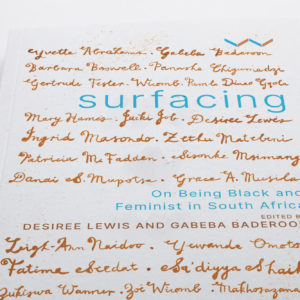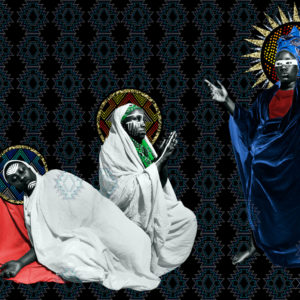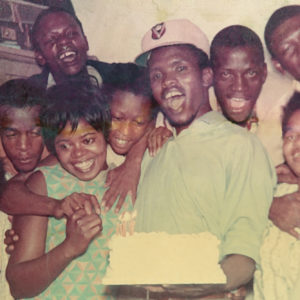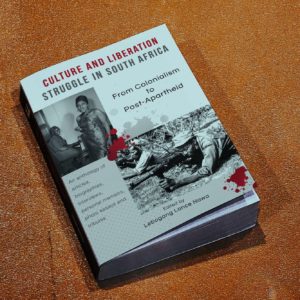New Books | ‘A Black Gaze’
Tina M Campt shows that Black contemporary art pushes viewers out of passivity and into a visceral, responsive interaction with the suffering and joy of Black life.
Author:
25 October 2021

This is a lightly edited excerpt from A Black Gaze: Artists Changing How We See (MIT Press, 2021) by Tina M Campt.
“I broke the internet, ya’ll.” It was the first thing he said as he walked through the front door, dragging the massive case that had become his trademark accessory. He’s the only person I know who travels with a desktop. He places no trust in external hard drives or laptops. He’s only comfortable when he has direct access to his entire archive, because you never know what you might need.
“What do you mean, you broke the internet?” We posed the question in feigned disbelief because, knowing AJ, anything was possible. “I always wanted to be able to say I broke the internet, but I never thought I’d actually be able to do it,” he continued, chuckling sheepishly. “But what exactly do you mean? How did you break the internet?” we asked again, this time with a combination of impatience and anticipation of the story to come.
The summer of 2017 in London was one of those glorious summers that (prior to global warming) was a rare occurrence. It was hot and sunny, and it hadn’t rained in days. And for precisely this reason, it was the kind of summer in London I never actually trusted. Something about the way AJ shook his head and chuckled like a big kid who couldn’t believe his luck felt somehow similar: an appreciation tinged with disbelief in anticipation of something new that was just beginning to come into view.
Related article:
It was the same feeling I had experienced a year before when I watched one of his recently completed films on my computer and found myself trying to move my seat closer and closer to the screen. Somehow I couldn’t get close enough. It was like nothing I’d ever seen before – a video that made me grin and giggle with delight at its gorgeous images of Black people in all their vexed glory, and a split second later, moved me to tears of rage at the endless cycle of violence and suffering it depicted directly alongside so many uplifting scenes of Black joy and pleasure.
I had met Arthur Jafa (known to friends and fans as AJ) in August 2016. He had recently finished Love Is the Message, The Message Is Death, the video I couldn’t get my seat close enough to. It is a piece that would explode in the art world in 2017, and simultaneously develop an ardent following far beyond the walls of the high-end galleries and art festivals where it would be screened across the globe. It was this ability to converge high and low, fine art and popular culture that, in the hands of Arthur Jafa and his collaborators at the production collective TNEG, “broke the internet” in the summer of 2017.
When he arrived at the doorstep of my temporary Dalston digs, he was the same person I had met the previous year, humble and gifted and in a state of disbelief that so much had happened in one short year. I was equally humbled and in disbelief – humbled to have been fortunate enough to know him at this critical point in his career, and equally fortunate to share an anticipation of what he has since described as “a tsunami” of work by Black artists that was poised to take the world by storm.
He had arrived predictably late. It was just after midnight and it was only because we were ridiculously jet-lagged that we were even awake. I had arrived several days earlier and was housesitting for a friend who was on vacation. My friend Saidiya had arrived the day before from New York and decided to stay with me because she said her hotel made her feel she was living in a dorm. She and AJ were old friends, and it was she who had introduced us and introduced me to his work.
Related article:
While AJ is well known for his troubled relationship to punctuality, this time the delay was for good reason. He’d been working alongside his TNEG collaborators around the clock doing final edits on a Jay-Z video that had dropped only hours before. He then hopped on a redeye from LA for a series of events linked to his own show in London. After over 30 years of producing scores of critically acclaimed work, his first solo exhibition had finally opened in none other than the storied halls of the Serpentine Galleries.
When Jay-Z’s music video, 4:44, dropped earlier that day on his proprietary music-streaming platform Tidal, the internet momentarily crashed as users inundated the system attempting to view it. Needless to say, Jay-Z is a master of promotion and timing, and his commercial savvy is nothing less than legendary. But this carefully cultivated anticipation was stoked as well by both the success of Love Is the Message and Jafa’s reputation as a fine artist with street credibility and a gift for visualising the beauty and grit of the Black experience.
Things had come full circle in the summer of 2017, and I mean that quite literally. It truly felt as if the day 4:44 broke the internet was the culmination of a year of encounters that set me on a path to this book, and to a series of insights and observations about a phenomenon I have come to describe as a Black gaze.
It’s a fact I’ll happily cop to for the record: I am unapologetically enthralled by the everyday photographs created by Black communities. Photographs speak in unique ways to our circumstances. They talk back to power, and they talk around and in between its silences and absences. Yet, while some of the most compelling images of the African American experience have historically been still photographs (the raised fists of Tommie Smith and John Carlos at the 1968 Olympics, Martin Luther King Jr addressing the masses assembled at the 1963 March on Washington, dignified and defiant portraits of Frederick Douglass and Harriet Tubman, marshals escorting Ruby Bridges to school or Black protesters being attacked by police dogs), I am struck by the fact that the end of the 20th century and the beginning of the 21st have ushered in a profound shift in the image-making practices of Black communities.
It is to the moving image, rather than still photography, that our communities now turn to capture the increasing precarity of Black life – that is, the precarious circumstances of Black people and the increasing prevalence of premature Black death. And it is through digital rather than analog technologies that we now document, archive and disseminate the mounting threats to Black communities. But we are also using these technologies to catalogue our everyday lives, the beauty of our bodies, our naïve and bold aspirations, and our hopes and dreams for changing our current reality. Our repository is no longer handmade albums or scrapbooks; it is now Facebook, YouTube, Instagram, (Black) Twitter and numerous other self-curated online collections made by ordinary people seeking to capture the vicissitudes of Black life. It is this burgeoning archive of amateur digital imagery that recurs repeatedly and with devastating effect in Arthur Jafa’s most impactful works. And they resurface yet again in 4:44.
Related article:
Like 4:44, Jafa’s most captivating works (among others, Dreams Are Colder Than Death; Love Is the Message, The Message Is Death; Apex; and The White Album) are films created from precisely this everyday archive of Black precarity. He spent years collecting videos and images from Facebook, Twitter, YouTube and numerous other sources made by Black communities to document the highs and lows of their day-to-day struggles. He stockpiled them as files he accumulated on the mobile second-brain repository that is the desktop he drags from pillar to post across the globe, and which he dragged into my borrowed Dalston flat in the summer of 2017. My first encounter with AJ in New York in August 2016 and our encounter in London in July 2017 are the double-sided, swinging doors that unlocked an ongoing encounter with a Black gaze.
By all accounts, we find ourselves in the midst of a Black artistic renaissance. Power brokers like the dynamic duo known as The Carters (aka Jay-Z and his partner in all things musical, Queen Beyoncé), Rihanna, Spike Lee, Shonda Rhimes, Ava Duvernay, Barry Jenkins, Steve McQueen, Oprah Winfrey and Tyler Perry are some of the many cultural and artistic icons who are reshaping the circulation of blackness on a global scale. Their influence cannot be explained by any single factor, for they come from a diversity of backgrounds, generations and media. They are influencers who hail from the US, the UK, the Caribbean and the African continent, and their impact is felt across multiple media, from music to dance, criticism, video, film, artwork, fashion and design.
This is certainly not the first time that Black artists have made a profound impact on the cultural politics of this nation or others across the globe; they are in fact part of a long and ongoing tradition of Black artistic intervention in the culture and politics of societies across the African Diaspora. In the US, the roots of this particular artistic outpouring can be traced back to its predecessors in the Harlem Renaissance of the 1920s and the Black Arts Movement of the 1960s and 1970s. Both, in their own way, heralded the emergence of politically motivated Black poets, writers, artists and musicians whose creative practices were intended as an affirmation of Black aesthetics, culture and consciousness.
The ascent of the current group of Black artist-entrepreneurs has been enabled by the technological advances of the internet and social media, which have allowed individual artists direct access to modes of production, marketing and most significantly, to media outlets and audiences that were previously out of reach except by way of largely white gatekeepers in the music, television, film and publishing industries. Contemporary Black artists are not only able to circumvent these gatekeepers; they are, in turn, creating new outlets for themselves and other emerging artists.
Related article:
But while contemporary Black-produced popular culture brings broader visibility to Black life and history, more often than not its emphasis centres on the depiction of Black people and communities, while maintaining existing limitations of traditional ways of narrating the Black experience. Although it often proceeds from a Black point of view, its major accomplishment is frequently that and that alone. It adds an additional perspective – a Black perspective – but it doesn’t necessarily challenge the fundamental premise of the existing framework for viewing blackness. It does not challenge the fundamental disparity that defines the dominant viewing practice: the fact that blackness is the elsewhere (or nowhere) of whiteness.
In this approach to Black visuality, while blackness is now seen (ie, made visible to a wider audience), it is not necessarily something to be felt. Much too often, Black life is rendered in ways that allow it to be engaged at a safe distance or viewed at arm’s length through a lens of pity, sympathy or concern. It is a temporary point of connection, visited and left behind in the face of an inevitable return to the comfort and comforting perspective of self and “home”.
My point here is not that there was no innovative Black art that preceded or informed the current moment – very much to the contrary. My focus is on how certain contemporary artists are building on these innovations, not only in film and popular culture where their impact is certainly manifest, but more notably in the field of fine art. Here the radical question they are posing is: rather than looking at Black people, rather than simply multiplying the representation of Black folks, what would it mean to see oneself through the complex positionality that is blackness – and work through its implications on and for oneself?
Alongside the aforementioned explosion of work by Black artists in mainstream popular culture, a group of Black fine artists are initiating a different and, I would argue, more transformative cultural, aesthetic, and indeed, political shift that is drawing unprecedented attention. They are shifting the very nature of our interactions with the visual through their creation and quite literal curation of a distinctively Black gaze. It is a gaze that is energising and infusing Black popular culture in striking and unorthodox ways. Neither a depiction of Black folks or Black culture, it is a gaze that forces viewers to engage blackness from a different and discomforting vantage point.




